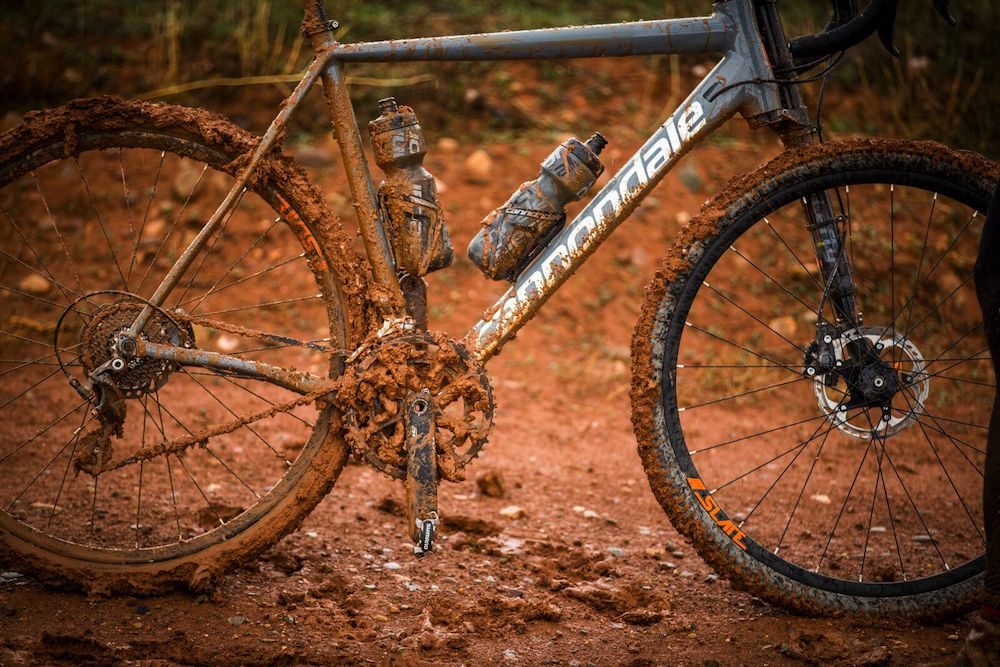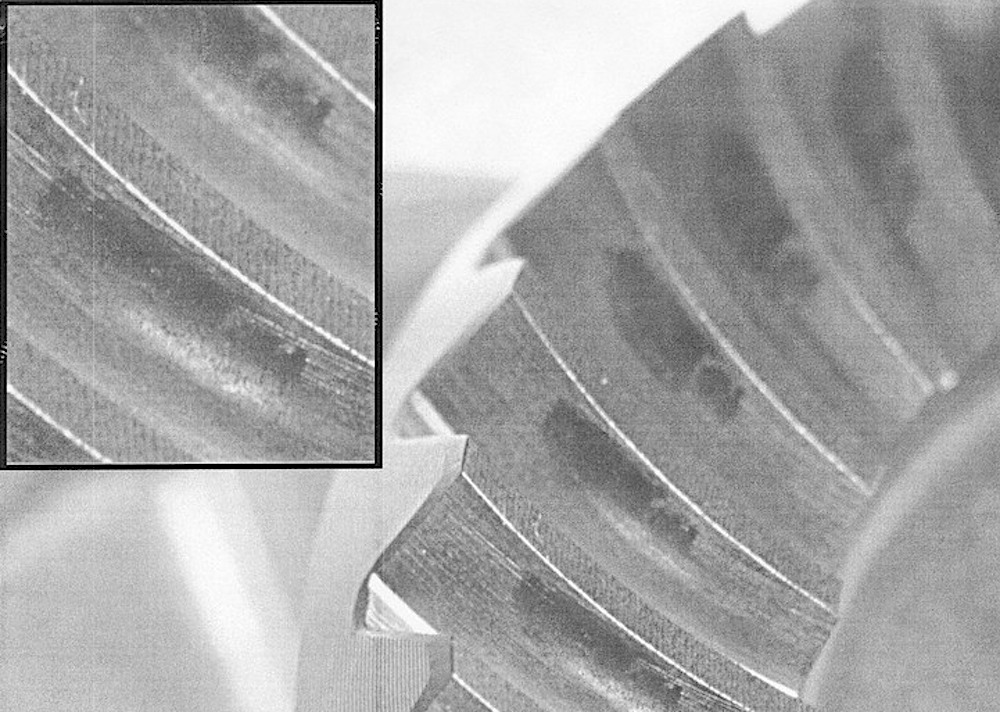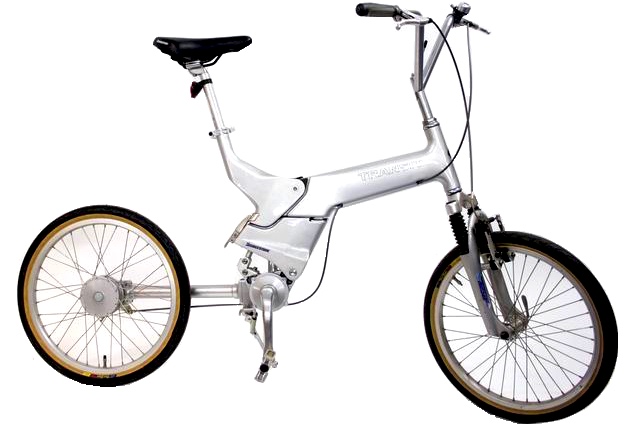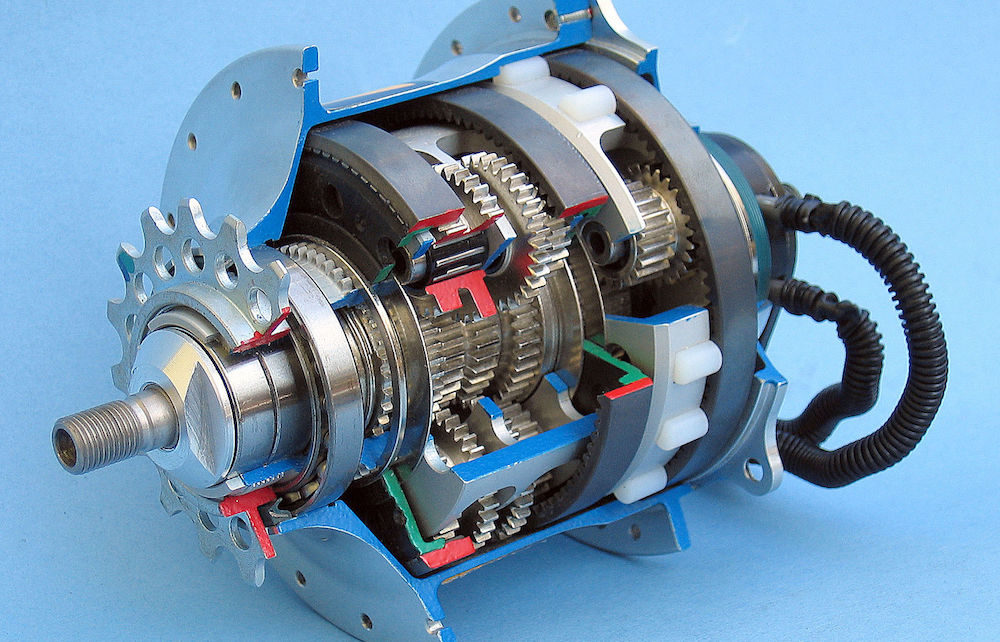We need to get our pedal power from the cranks to the rear wheel somehow.
Chains are clearly the most common way to propel us forward, and if you’re a regular reader here, you’ll have seen that I think belts are perfect for long-distance bike travellers.
There are far quirkier ways to propel a bike too, including shaft drive, hydraulic drive and even string drive!
In this article, you’ll find out all of the reasons why shaft drivetrains have not succeeded in the bicycle world. Make sure to stick around until the end, because we will be using our shaft drive knowledge to assess the interesting new Driven drivetrain.
What is a Shaft Drive Bicycle?
Drive shafts are commonly used in automotive and industrial applications. But what you may not know is that they’ve been used on bicycles for over 125 years.
Instead of using a chain and sprocket set up to rotate the rear wheel, two sets of bevel gears transfer energy to the rear wheel via a drive shaft. The entire drive system is usually housed in an aluminium case that doubles as the right-hand side chainstay of your frame.
Shaft drive bicycle manufacturers – who still exist today – promise no exposed moving parts, no greasy or broken chains, and no skipping gears, which all sound pretty good to me.
So, why have these drivetrains never taken off?
Derailleur Drivetrains Are Exceptional

Derailleurs are undoubtedly the best drivetrain for the majority of cycling applications.
They are cheap to manufacture, lightweight, highly efficient, and with over a century of innovation – they work really well too. Derailleurs can also be fitted to almost all bikes, you can easily source replacement parts, and you can find someone who can adjust them in most towns.
As a shaft cannot be paired with derailleurs, this is a major reason why shaft drive bikes are not more widespread.
But if you prize the ability to go huge distances on your bike with almost no maintenance, or the ability to ride in horrific weather conditions without gear adjustment, gear skipping or the need to clear debris from your drivetrain – this is where gearbox systems shine, and shaft drive can be paired with an internal gear hub.
So, for the rest of the comparison, we will be assuming someone already wants a low maintenance gearbox bike but is deciding between using chains, belts and shafts.
Reduced Drive Efficiency
A shaft drivetrain has a lower efficiency than a chain or belt. The biggest energy losses are simply due to the change in rotation direction – once at the crankset and once again at the rear hub.
We don’t have a lot of efficiency data available here, but in 1983 Josef Keller compared an unspecified shaft drive with a singlespeed chain, and found a 7% difference in drive efficiency in the shaft. This was between 50 and 200 watts pedalling output (Radmarkt 12/1983, “Der Wirkungsgrad im Fahrradantrieb”, page 71-75).
Friction Facts have tested a singlespeed chain to be about 99% efficient at 150-watts (2-watts drag), and a belt drivetrain to be 98.6% efficient (2.45-watts drag) at 250 watts power output. Using this current data, it would mean a shaft drive is around 92% efficient (12-watts drag). That said, chains and lubricants in the early-1980s were not as good as they are today, so shafts are more likely to be less than 90% efficient.
I know these numbers don’t sound like a lot, but let’s say a 70kg rider with a 15kg shaft drive bike was riding up a hill with a 5% gradient. After 10km of riding (or approximately an hour) the shaft drive bike would be four minutes behind the chain drive bike (150 watts power output).
Then again, chains and belts lose efficiency in wet or muddy riding conditions. Friction Facts has found a chain to be 94.4% efficient in muddy and wet conditions, and 92.8% efficient in muddy and dry conditions (250-watts).
So in ridiculously muddy conditions, a shaft could technically work out to be more efficient than a chain or belt (assuming you don’t use a chaincase). Or another way to look at it, a shaft in good conditions is as efficient as a chain in super muddy ones.
Extra Weight

A shaft system also requires very heavy-duty components, resulting in a weight penalty of 1-2 kilograms compared to a chain or belt drivetrain.
These heavy components are absolutely necessary as shaft drivetrains undergo very high forces when a rider starts from a standstill.
This is a particularly big hurdle on shaft drivetrains as they use small radius bevel gears. It results in much higher forces and distortions when compared to chain or belt drive.
Or to be more technical, the moment arm on a shaft drivetrain is approximately 4-8x shorter than a chain or belt cog, so it needs to be engineered to handle 4-8x more force. These high forces also put a lot of stress on the bearings and bevel gears, which can wear out very quickly if not engineered to the right specifications.
Ok, but what if you don’t care about efficiency or weight?
Gear Alignment

Another hurdle for shaft drive systems is gear alignment.
In order to reduce wear and increase drive efficiency, there is an optimal distance for the bevel gears to mesh.
All bicycle frames flex under a load, but if a frame is not stiff enough for a shaft system, it can result in imprecise gear meshing.
A proposed solution has been to use CV joints at both ends of the shaft. This would allow the frame to flex, but would also introduce more friction, weight and complexity.
A shaft system also needs to be constructed to very tight tolerances to achieve the optimal gear meshing, and additionally, the rear bevel gears need to be easily aligned by the user when installing the rear wheel.
Gear alignment is a very solvable problem but requires the appropriate frame, manufacturing tolerances and way to achieve the optimal distance between bevel gears.
Proprietory Parts

Ok, so you now have a super stiff frame and a shaft drivetrain that’s really well-designed and manufactured.
Shaft drive systems and the frames they’re built around are proprietory. This means that if you have a problem with your shaft or can no longer get replacement parts, you cannot switch your drivetrain to a belt or chain instead – your bike will have shaft drive until the end of days.
Right – before I summarise everything, let’s talk about the prototype shaft drivetrain by Driven Technologies.
The Driven Drivetrain

This is a slightly different take on shaft drive, as it transfers power via a series of cartridge bearings that intermesh with two circular pinion arrays.
An awesome thing about the Driven drivetrain is that it doesn’t need to be paired with an internal gear hub, which allows it to theoretically provide a very high drive efficiency in every single gear – Driven are claiming 99% or higher. In comparison, the best internal gear hub that we’ve collected data on is 92 to 97% efficient depending on the gear selected.
While the Driven drivetrain has been taken up to 45kph on a velodrome, there are significant challenges around making this drivetrain viable in the real world.
Managing the low-RPM force is going to be a huge challenge and will require very advanced materials to achieve the appropriate strength and longevity of the pinion arrays. Driven will also need to ensure riders do not exceed the static load rating (Cor) of the small cartridge bearings too.
Driven’s CEO recently acknowledged these two hurdles in an email to CyclingTips, stating that what we’ve seen is far from the final product and that he’s confident these engineering challenges can be solved.
Driven has just received a million dollars in external investment, so it will be interesting to see if they can finally get this drivetrain off the ground.
And one final note on Driven – creating a rear frame triangle that is stiff enough to achieve precise gear meshing is another big hurdle. This will go against the current trend of reducing frame stiffness to improve the ride ‘quality’ or ‘feel’ of your bike – you can learn more about the nuances of frame stiffness in my article HERE.
Summary
Shaft drivetrains have a great reputation in the motorbike world. But in that world, the extra weight and lower drive efficiencies can be overcome by using more powerful engines.
Bicycles on the other hand are always best when the effort you’re putting into the pedals is rewarded by propelling you along efficiently.
I hope to see more shaft drive innovations in the future because I just think they’re super cool. But they have a lot of hurdles to overcome. Other than the additional weight and reduced drive efficiency, they require super-stiff frames, components built to very tight tolerances and easy user alignment of the rear bevel gears.
Chains are still the best option for most people, as they can be paired with cheap, light and efficient derailleur gears. But if you like the idea of a gearbox like the Rohloff or Pinion, I can highly recommend pairing those with low-maintenance, long-lasting belts.
Pros of Shaft Drive
– Low maintenance
– Could be more efficient than a chain/belt in super muddy conditions
Cons of Shaft Drive
– Cannot be used with the most popular bicycle gear system (derailleurs) or crank-based gearboxes like the Pinion P1.18
– Low drive efficiency (~92% shaft vs ~99% chain)
– 1-2kg heavier than a chain or belt system
– Requires a stiff frame, components built to tight tolerances, easy user alignment of the bevel gears
– Proprietory frames and shaft components mean you cannot switch to a chain or belt
– Replacement parts are very hard to source









